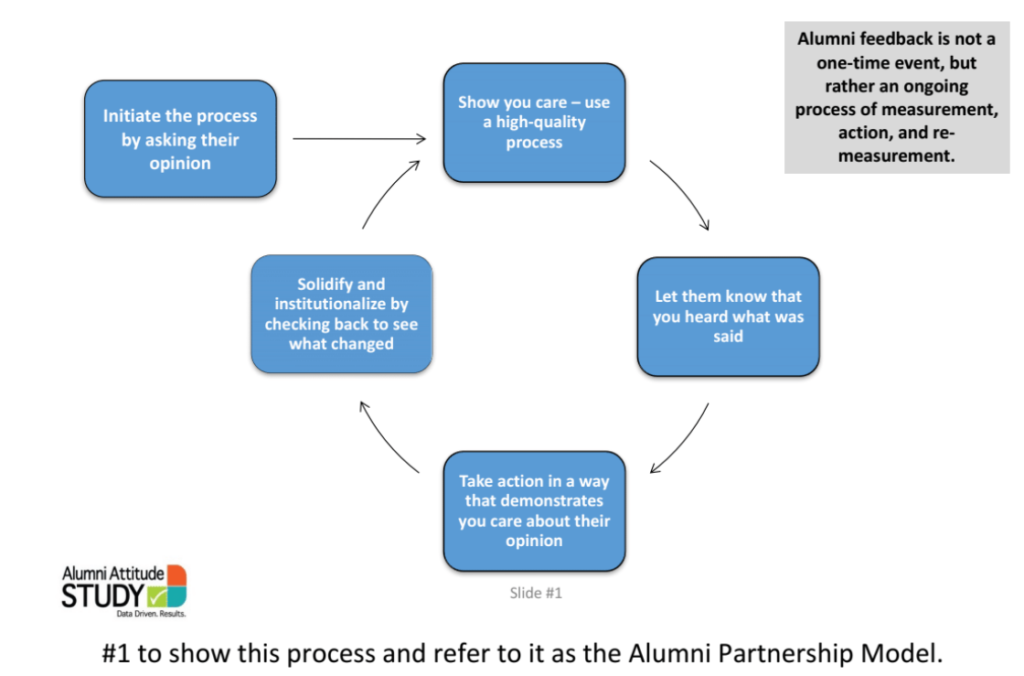Many universities and colleges choose to survey their alumni to gain insights into what motivates them and find answers to critical questions. They aim to identify which articles or topics have the most significant impact on engagement and which talking points prove most effective. Amid these considerations, it’s crucial not to overlook that another equally important process is unfolding simultaneously. Engaging with alumni means entering into a conversation with them, and this interaction holds significance. Interpersonal skills training underscores that showing care involves seeking someone’s opinion. Nevertheless, this is just the beginning of a more comprehensive process.
After seeking opinions, several subsequent steps must be taken. First and foremost, it’s essential to ensure that alumni can perceive your attentive listening. In the context of a survey, this can involve utilizing a well-designed instrument that emphasizes the significance of the process and their input. Subsequently, rephrasing their information and echoing it back to them is valuable. This demonstrates that you have genuinely absorbed their perspective and are, according to it, due attention.
Moreover, it’s crucial to keep alumni informed whenever action is taken based on their feedback. Finally, it is vital to convey that this is an ongoing interest in their viewpoints rather than a one-off occurrence. PEG, Ltd. terms this approach the Alumni Partnership Model. 
Conducting alumni surveys establishes expectations for those who receive the survey and those who respond. By reaching out for their time and opinions, the university creates an expectation that their input will be genuinely considered, leading to actionable change. The accurate measure of the value placed on alumni opinions lies in the tangible evidence of positive change within the association.
The university bears the responsibility of communicating the study’s results. Ideally, this response should manifest in two primary ways. First, a communication should be sent to all alumni, summarizing the study’s outcomes and the initial commitments to act upon those findings. Tailored follow-up communications should also be sent to specific segments of the alumni population. Secondly, the results should translate into action, with these actions being publicly linked to alumni feedback.
When individuals are requested to share their opinions and they oblige, it initiates a conversation that resembles a partnership. This survey establishes a connection with numerous alumni, many of whom provide positive feedback. Such engagement is to be celebrated. However, the survey also reveals areas that demand improvement, posing challenges. One unmissable truth emerges amid the verbatim comments and discussions: not acting upon this valuable feedback would mean forfeiting a substantial opportunity. Particularly when emotional attachment is involved, individuals overwhelmingly seek to be heard. Surveys offer a streamlined and effective means of obtaining this input. Across the nation, it’s evident that alumni are keen to provide their opinions and engage in a dialogue through surveys conducted by their alumni associations.
Institutions that display responsiveness to the feedback they receive and take action based on the results reap the most significant rewards, fostering stronger relationships with their core constituents. Segment-specific follow-up communications are recommended. Acknowledging initiatives that align with the survey findings or are sparked by them further enhances the relationship. This approach fosters an interactive relationship, making alumni feel integral to the process. A significant metric in survey work is the response rate. Time and again, evidence confirms that when people believe their opinions hold weight, they increasingly participate over time. The converse is equally valid.
